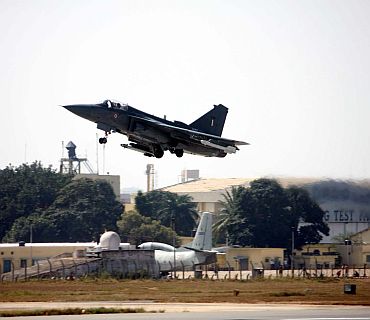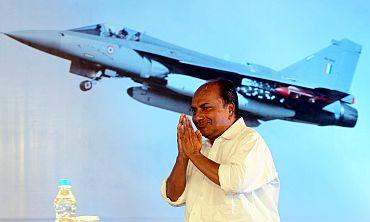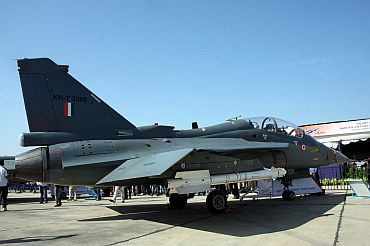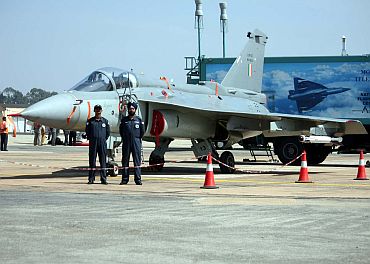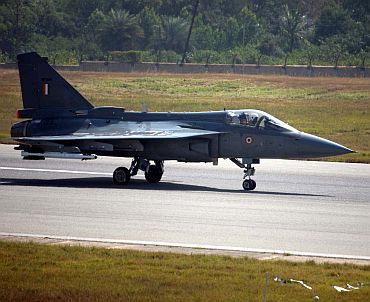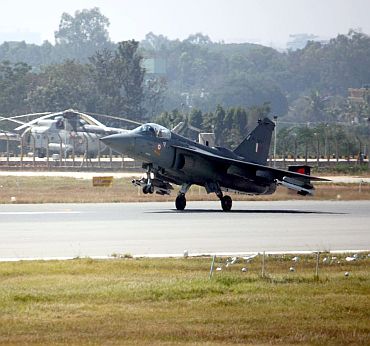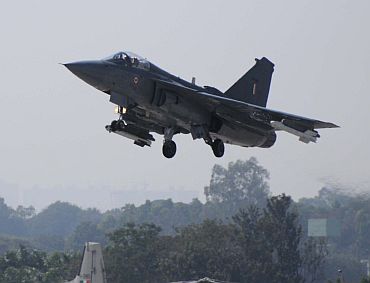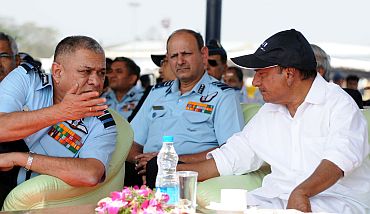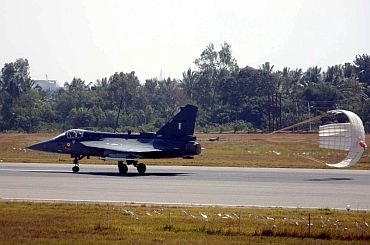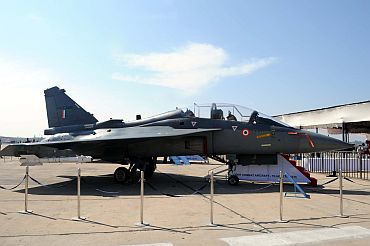 | « Back to article | Print this article |
In PHOTOS: 'Desi' fighter ready for IAF
In a major military aviation milestone, India's home-grown Light Combat Aircraft Tejas on Monday secured the Initial Operation Clearance taking it a step closer towards induction into the Indian Air Force.
In a feat that came a decade after the multi-role LCA took to the skies, Defence Minister A K Antony handed over the IOC certificate to Air Force chief Air Chief Marshal P V Naik at the HAL Airport in Bengaluru.
Click on NEXT to see kore PHOTOS of the Tejas...
In PHOTOS: 'Desi' fighter ready for IAF
Antony said the IOC certification would facilitate delivery of the first lot of 20 production standard aircraft to the IAF with assured safety and specified performance before the end of the year.
"This is only the semi-finals", Antony said, adding the LCA would enhance national security and build the country's own fighter aircraft capabilities.
The IOC comes after over three decades of LCA development and research spearheaded by Aeronautical Development Agency, surmounting technology denial regimes.
In PHOTOS: 'Desi' fighter ready for IAF
The light-weight Tejas, presently powered by American GE-F404 engine, has been developed from the scratch, putting India in the select club of nations, including US, Russia, France and Britain.
The Flight Test phase of Tejas was initiated in January 2001 and it had completed 1,508 flight tests using various variants, including first two-seater trainer version.
Antony said, "After crossing a number of challenges and accomplishing a significant series of milestones including weapon delivery, in over 1500 sorties, the country is poised for a major turning point with the declaration of the IOC."
In PHOTOS: 'Desi' fighter ready for IAF
The development of the aircraft, primarily to replace the ageing Russian MiG-21 and MiG-27 fighter jets, was affected by the US sanctions in 1998 that led to delay in importing some items and developing alternative equipment, since vendor identification and development to production cycle took time.
After the IOC, the LCA will undertake several flying missions before obtaining its Final Operational Clearance (FOC) for induction into IAF's operational service, likely by the end of 2012.
The IAF had in March 2005 placed orders for 40 LCAs, which would be powered by the American General Electric GE-F404 engines, 99 of which are to be purchased under a deal with the company. The first of LCA squadrons will be based at IAF's Sulur airbase near Coimbatore in Tamil Nadu.
In PHOTOS: 'Desi' fighter ready for IAF
Antony said there was scope for supplying more Mk2 variants of the Tejas to Navy and Airforce. The requirement for Tejas is estimated at about 200 aircraft and the country would shortly see the first flight of LCA's Navy variant.
About India's focus on defence and national security and the various programmes, including Mark II variants of Air Force and Navy, the Advanced Medium Combat Aircraft, the unmanned aircraft and unmanned air combat vehicles, he said, "The military aviation programmes in the country have been given a major thrust in the recent past."
"The Airborne Early Warning and Combat Aircraft is ready for rolling out in January next with flight trials starting by the end of the year," he said.
In PHOTOS: 'Desi' fighter ready for IAF
Antony said the successful completion of these programmes would lead the country towards self-reliance with the state-of-the-art technologies in the world.
The time has now come for our industries -- both public and private sector -- to manufacture these world-class military systems with highest quality and productivity, he said.
The Tejas programme, he said, would enhance technological base of aeronautics in the country and "act as a stepping stone for future programmes."
In PHOTOS: 'Desi' fighter ready for IAF
The Release to Service certificate has been prepared by RCMA(A/C), an organisation of Centre for Military Airworthiness and Certification (CEMILAC) after scrutinising the design, development, equipment testing and flight testing results of all systems of Tejas over the last several months.
This is the first time that an indigenously designed and developed military fighter aircraft is being certified for Air Force operations. After this, Tejas aircraft will be available for use by the Indian Air Force pilots.
Describing the event as an "important milestone" in Indian military aviation, the Air chief Marshal said, "Tejas taking wings is like a dream come true for all of us."
In PHOTOS: 'Desi' fighter ready for IAF
The Tejas programme had come a long way from its initial stage of conception. The programme had been redesigned and realigned during the period to ensure its contemporariness and its ability to keep pace with modern technology, he said.
However, he pointed out that there was a lot of work that needed to be done and improved upon before its final induction into the Armed forces and for ensuring that it was 100 per cent ready for squadron use. Full operational clearance was expected to take some years, he added.
The development of the indigenous aircraft would help India stride towards the path of self reliance and joining the select club of nations that had the research and development capabilities to develop an aerial combat platform, defence officials said.
In PHOTOS: 'Desi' fighter ready for IAF
Scientific Advisor to the Defence Minister Dr V K Saraswat said it was 'a red letter day' and the IOC had come after over two decades of sustained research and development. "It is like writing a new page in the history of Indian aeronautics."
During its development stage, modern technology has been incorporated in the aircraft and stringent standards adhered to, he added.
P S Subramanium, Director ADA, said the LCA programme had progressed satisfactorily and established the "required aeronautical base in the country".
In PHOTOS: 'Desi' fighter ready for IAF
Subramanium said the LCA was expected to secure its Final Operation clearance by 2012 and have the first delivery of 20 aircraft by end 2013 and the next 20 in two and half years. The mark-II version flight trials were expected in December 2014 and production in June 2016.
HAL Chairman Ashok Nayak said, "The LCA has come a long way".
It faced "technical challenges", most of which have been successfully resolved though with some time overlap.
